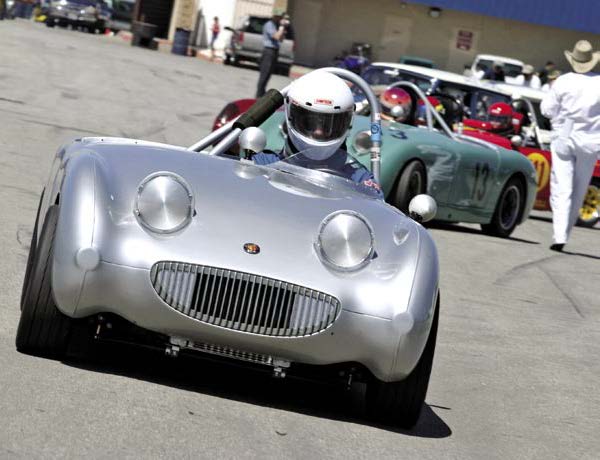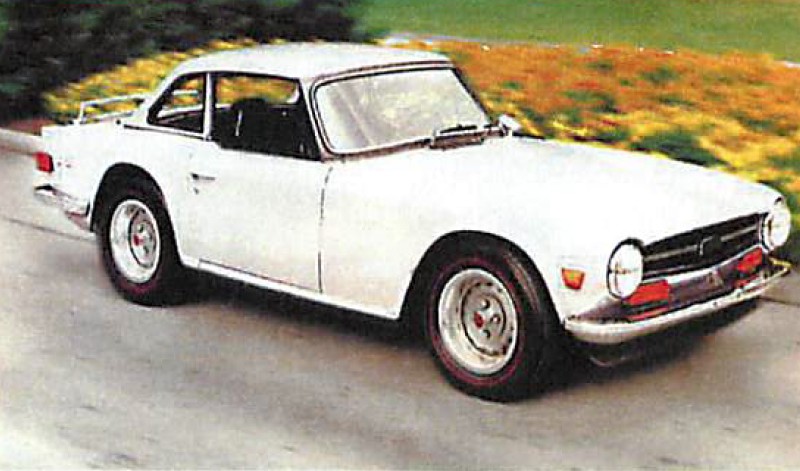I could never understand why there was such a general dislike of the MGC, which was introduced in October 1967. The “Big” Healey had been a pretty popular and successful sports car, but the MGB’s chassis was far superior, lighter, and handled better than the big brother.
I also couldn’t quite figure out why there was (and still is) such an intense rivalry between A-H and MG, which were put together out of many of the same BMC bits, on the same Abingdon assembly lines, and by the same skilled and dedicated workforce.
Those of us who were fortunate enough to be “works” drivers always enjoyed an outing in the MGB. On the two occasions I crewed one on the incredible Tour De France Automobile, I was mostly seen wearing a big grin!
One rally, I was with Andrew Hedges in the ex-Le Mans “droop snout” model. Andy simply creamed the opposition—including all the GTO Ferraris and Porsches, up both the big hill climbs in Pyrenees.
Andrew this this by taking half a minute off these much more powerful cars, mostly because of his bravery in the fog, as well as the MGB’s incredible roadholding. However, we always craved more power—and what driver doesn’t? So the idea of putting in a bigger engine with more torque and horsepower seemed to be just what the doctor ordered, and that what Abingdon did with with the MGC. Just imagine Healey power, without the noise, smell, and heat—and with civilized doors and windows!
The MGC handled amazingly well. The GT tipped the scales at about one hundred weight more than the tourer, but because of the extra weight was over the rear of the car, it evened up the weight distribution a little. There was no feeling of excessive understeer, and on lightly studded tires, it coped superbly with the ice and snow. Even in normal road driving, I’d never felt it about to plough straight on through terminal understeer—it was particularly sensitive to tire pressures. The MGC had a much stronger shell than the Big Healey and was a damn sight more civilized to boot—and booting it was just what I was enjoying doing!
Of course, a front-engined rally car is no bad thing, since the weight holds in front of the car down on the road while you play tunes with the throttle to bring back end round to where you want it. That takes courage on ice, believe me, but with all that lazy torque available, exactly when you needed it, the MGC could be hustled through the mountains at a fair old lick.
In January 1970, one of Britain’s leading newspapers, the Daily Telegraph, sponsored me on the famous Monte Carlo Rally. The plot was actually to see if a privately owned sports car—with more than 10,000 miles of normal use on it, and without modifications—stood any chance against the highly modified professional teams. Gerry Ryan agreed to join me in setting out on an international rally in a genuine, second-hand 1968 MGC GT Coupe (my wife’s!).
The plan was simply to give the car a 12,000 mile service, and there were also a couple of things I rather wanted to improve. First, the standard shock absorbers would have stood no chance against the rutted snow on some of the roads in the mountains. Secondly, the generators were still a bit new and were not yet very reliable, so I wanted to fit an uprated version from the Lucas Competitions department (pause for obligatory Prince of Darkness joke!), to cope with the long nights of lights on, wipers on, and a heater blower going full blast! As it turned out, my workshop boss, Steve Luffrum, was unable to locate either of these items in the short space of time we had to prepare the MGC, so off we went, without them. Off to Prince Rainer’s kingdom in a totally bog standard car!
We lasted for three of the four days, keeping up with all but the most powerful factory cars. Even Tony Fall, in a works Lancia, came up to me and said how well the MGC seemed to go, and how he thought he would catch ‘.Is easily mi the special stages. (He didn’t!) As I’d anticipated, however, the rear dampers began to fade, and as we bounced down through the Basse Alpes it became more and more difficult to maintain competitive speeds. Even so. We were by no means disgraced when the alternator decided it was time for a service, resulting in just a glimmer from the headlights. By chance, just as we were arriving at one special stage, the side of the mountain erupted in a forest fire. As we were held up at the start for over an hour, it gave me time to rebuild he offending alternator. We had to he careful with the lights, but at least we till rolling… or bouncing anyway!
Unfortunately, the rear dampers had absorbed all the shocks the) were going to —with the back of the MGC bucking and feeling about to leap off 9,000 feet of mountain! Going Outside Time Limits suddenly seemed preferable to going over the edge,and Gerry and I decided that further progress along the rally route would seriously endanger our chances of making the party. So we cut off direct to Monaco instead. On thew ay home, on smoother roads, it only took us a few hours to cover the 500 miles to Channel Ports, and we were on the ferry home before the rally finished.
Even so, we both loved the car, which had ample power, excellent braking, and better traction than any works Healey. With its coupe top, the MGC was quiet and comfortable as civilized a Grand Tourer is you could wish. While we were not able to prove that a privateer in a stock MGC could beat the professionals, at least we showed the capability of this Abingdon product, enjoying a comfortable and quiet interior with a decent radio and heater, all in four days of nonstop motoring in the dead of winter.
So, when anyone starts to go on about the shortcomings of the MGC, I do get a bit hot under the collar and wonder if they ever really drove one of these delightful cars!
By John Sprinzel
Excerpted from North American Classic MG Magazine







'MGC: The Orphan of Abingdon' has no comments
Be the first to comment this post!